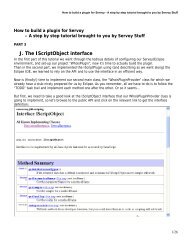Step by step tutorial: how to build a bean for Servoy - Servoy Stuff
Step by step tutorial: how to build a bean for Servoy - Servoy Stuff
Step by step tutorial: how to build a bean for Servoy - Servoy Stuff
Create successful ePaper yourself
Turn your PDF publications into a flip-book with our unique Google optimized e-Paper software.
How <strong>to</strong> <strong>build</strong> a <strong>bean</strong> <strong>for</strong> <strong>Servoy</strong> - A <strong>step</strong> <strong>by</strong> <strong>step</strong> <strong>tu<strong>to</strong>rial</strong> brought <strong>to</strong> you <strong>by</strong> <strong>Servoy</strong> <strong>Stuff</strong><br />
public IComponent getBeanInstance(int appMode, IClientPluginAccess<br />
paramIClientPluginAccess, Object[] paramArrayOfObject)<br />
This method is called <strong>by</strong> <strong>Servoy</strong> whenever it needs <strong>to</strong> retrieve an instance of a component <strong>for</strong> the<br />
developer environment as well as the smart client and the web client. It receives 3 parameters:<br />
- an int which is the mode (see IClientPluginAccess constants <strong>to</strong> see that <strong>for</strong> the web it will be<br />
IClientPluginAccess.WEB_CLIENT = 5)<br />
- an IClientPluginAccess object (a pointer <strong>to</strong> the <strong>Servoy</strong> application)<br />
- an array of Object which are the parameters passed <strong>by</strong> <strong>Servoy</strong><br />
This method is called so that you can return an instance of the correct kind of <strong>bean</strong> (Swing or Wicket),<br />
but it is expecting an object that complies with the IComponent interface.<br />
Now we are lucky because this IComponent interface is actually public, so we can have a look at the<br />
javadocs <strong>for</strong> it. It defines 24 methods that we will have <strong>to</strong> implements (most of them are getters and<br />
setters, though).<br />
So the Swing <strong>bean</strong> and the Wicket <strong>bean</strong> <strong>to</strong> return will both have <strong>to</strong> comply with the IComponent<br />
interface. But we also know that <strong>to</strong> be able <strong>to</strong> use these as input <strong>bean</strong> they will need <strong>to</strong> implement the<br />
I<strong>Servoy</strong>AwareBean as well. And we also know that <strong>to</strong> be complete we need <strong>to</strong> deal with at least one<br />
more property: the dataProviderID. So that’s the ID of the interface we are going <strong>to</strong> add straight away<br />
in our main package, let’s see the whole code of it:<br />
public interface ITextComponent extends IComponent, I<strong>Servoy</strong>AwareBean {<br />
}<br />
public void setText(String paramString);<br />
public String getText();<br />
public void setDataProviderID(String dataProviderID);<br />
public String getDataProviderID();<br />
You see that I have <strong>build</strong> an interface, called it ITextComponent (we are <strong>build</strong>ing a text input <strong>bean</strong> this<br />
time), and I have made it an extension of both IComponent and I<strong>Servoy</strong>AwareBean. Then I added<br />
accessor methods <strong>for</strong> the 2 essential properties of our <strong>bean</strong>s: the text itself (a String) and the<br />
dataProviderID (another String which is the “key” of the value in our records).<br />
Note that as usual, you will have <strong>to</strong> type ctrl+space (cmd+space on Mac) so that Eclipse will add the<br />
import in the header of your interface:<br />
import com.servoy.j2db.dataui.I<strong>Servoy</strong>AwareBean;<br />
import com.servoy.j2db.ui.IComponent;<br />
Now that we have our interface ready, let’s <strong>build</strong> our Swing implementation (it won’t take <strong>to</strong>o much<br />
since most of the properties are already part of the JTextField we are going <strong>to</strong> subclass).<br />
2/37



